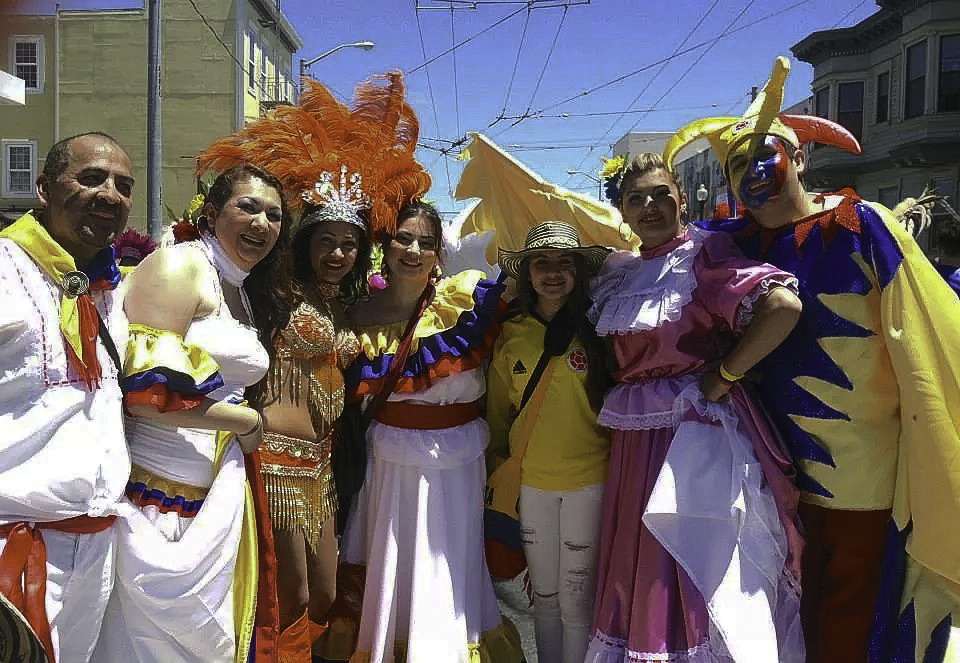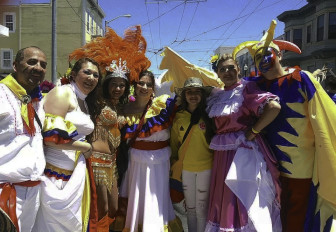
Standing in the busy streets of San Francisco, junior Anni Zarabanda felt entranced by a line of dancers swishing their colorful, traditional Colombian dresses. Celebrating Colombian Independence Day at a Latino-cultural festival, Zarabanda enjoyed the cumbia, Caribbean-style music from the coastal region of Colombia, as she watched the procession of women wearing bright orange feathered headdresses and men lavishly dressed in red, blue and yellow—the colors of the Colombian flag.
Zarabanda emigrated from Colombia in 2010, and attending the parade with her family is just one way that she keeps in touch with her roots. Zarabanda explains, “They understand what you grew up with. To bond with people like that is so great because you get a little piece of your country.”
“Every time a family member travels to Colombia, they always have to come back with Colombian food. It’s a way to keep in touch with the food over there,” Zarabanda adds.
Her mother and grandmother cook lots of Colombian dishes as well. She says, “Some of my favorites, are definitely empanadas. My grandma makes them, they’re homemade and they’re so good.”
One of Zarabanda’s favorite ways to keep her culture alive is through celebrations. She and her family put a traditional Colombian twist on New Year’s. Like some other cultures, the Colombians believe that certain objects and colors will bring good fortune for the New Year. She recalls, “You wear yellow underwear for good luck. And you put these beans under your bed and it’s supposed to mean money and wealth and I don’t know—it’s pretty weird. I’ve never tried it. I don’t think I will.”
When Zarabanda lived in Colombia, she used to run around her neighborhood on New Year’s Eve as well. There, the neighborhood represents the world, and running around it with a traveling bag symbolizes desires to travel the world. “You can put whatever you want [in the bags.] You can put money, clothes, whatever you want to gain throughout the year and whatever you want to gain [when] traveling. ”
To finish off the night, she’d begin “Doce Deseaos” (or Twelve Wishes), where at midnight each person grabs twelve grapes, each representing a month of the year. The person makes a wish on each grape of something that they hope to come in the New Year. “I actually did that. I always do it,” Zarabanda says.
Colombian society is heavily influenced by dance. “You kinda just grow up with it. I grew up listening to my mom play salsa and merengue, and when there were family parties, everyone would just start dancing. I don’t know exactly how I learned to dance—I just do it,” Zarabanda says.
However, Zarabanda also made room for new American ideas. “Since Colombia’s such a big Catholic country, pretty much all our festivities and everything are based on religion. But I’m not really religious because of this country. I identified with different people and I saw different perspectives, and I was like ‘I can have whatever beliefs I want.’ So it made me more diverse,” she explains.
The value of a woman is also higher in America than in Colombia. Zarabanda explains, “Here, a woman can fight, can make a living, can make it. While in my country, my mom struggled so hard because she was a single mom. She struggled so hard to get me and my brother to where we are right now.”
Though she’s lived in the U.S.A. for four years now, her constant immersion in her culture makes her feel loyal to her native country. “It’s great experience [living here] because you’re more open to everything. Now you don’t just have the point of view of your culture, but the point of view of other culture,” Zarabanda says. “But I feel like some [immigrants] feel the need to change [their culture] to be accepted, and I just didn’t believe that was right.”




